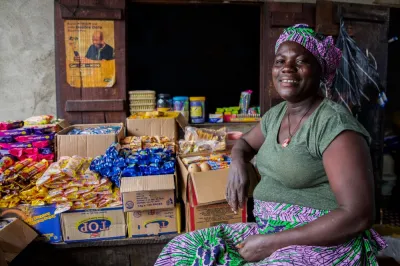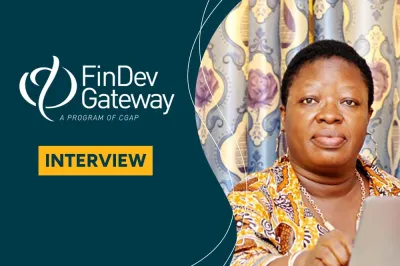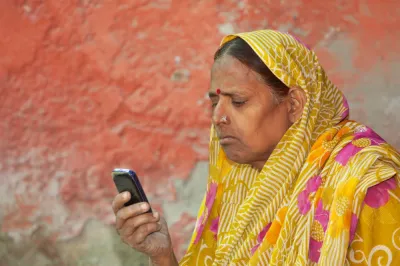Going Digital Is Not Enough to Reach Scale

Watching “Inside Bill’s Brain,” a Netflix documentary series, I was struck by Bill Gates’ approach to new development ideas. What’s important in thinking about a problem, he says, is to look for a solution with 7x or 10x impact. It’s all about “optimization.”
This left me wondering about microfinance’s own optimization problem.
What I mean is, how does microfinance get radically more efficient without losing what makes it distinctive? Its distinctiveness is its focus on the social good and the attempt to improve and indeed transform lives. By efficient, I mean the ability to deliver at significant scale, but at a fraction of current delivery costs.
Digitizing is not enough
As someone working to digitize Savings Groups, I am concerned that many see digitization, particularly digitizing the existing way of doing things in microfinance, as the answer to this optimization problem. But I don’t think that’s right.
While this type of digitization can appear to bring about progress with significant reduction of costs, a bigger opportunity might be missed. Don’t get me wrong: Of course, lower cost and quicker service to clients is a win. It is more optimal. But is it big enough to achieve true optimization with 7x or 10x current impact? I don’t think so.
So, what are we missing? I think that we need to look at a vital second element to achieve optimization. This means embracing a big shift in how work, and the people who deliver that work, are organized.
What is self-management?
Of course, self-management has been around a while. Craftspeople and artisans have managed their own work for millennia, and millions still do. Some are even MFI clients. What is different is the emphasis on building self-management at scale. A growing number of companies across the world have shown that it’s possible, such as Haier, a Chinese appliance manufacturer with 70,000 employees, and Buurtzorg, a Dutch home-care company with 14,000 employees.
What does self-management look like in a large company? Each organization has a slightly different model. But behind the variation in organizational structure, there is a single intent: Enable your people to do what they do best, in teams small enough to matter, but big enough to serve. For example, at Buurtzorg, the 1,000 staff teams are completely self-organized, and they take care of the entire health care process. Among other tasks, they take on new clients, plan their own work, deliver care to their clients and hire new nurses for the team. There is a small headquarters of about 50 people to support the front-line nurses. The model provides freedom with accountability, designed to bring employees as close to “their” clients as possible. It is hyper-efficient because it strips out unnecessary layers of bureaucracy and deploys staff right to the front line.
What would self-management look like for microfinance?
How does this apply to microfinance? I see its relevance as twofold. First, supporting clients who organize themselves through Savings Groups, ROSCAs, ASCAs, etc. This is self-management in action. Of course, many groups – but not all – need support to get going and sometimes to stay together. Beyond that, support includes providing the right digital tools to digitize record-keeping, member registers, share-out calculations and savings goals as well as provide financial education. And at the next level, it is about providing new digital services to expand the utility of the group to its members. This is what we are working on right now at DreamStart Labs: Services such as bank linkages, liquidity management, credit scoring, new product development and longer-term savings products – all designed to support self-managed savings groups.
Secondly, But to achieve these improvements, staff have to work differently. We need to move out of the rigid hierarchies of old to a network of self-managed teams, fully owned functions and autonomous branches. From centralized, rule-based authority to distributed decision-making where local teams serve local clients in ways they devise, and then share in the rewards for doing this well. It is a true revolution in how we do work. And yes, it can work in financial services, as an early Swedish pioneer, Handelsbanken, proves. With the new approach in place, digital tools can then enable front-line staff to deliver for clients at scale.
The 10x solution
We keep the sector’s focus on social impact and transforming lives, at the same time as we radically increase efficiency, allowing us to multiply the impact exponentially.
Call it the answer to microfinance’s optimization challenge, an organization revolution or, to put it more simply, a 10x solution.



Even if we agreed on the idea of fully digitization of microfinance still most of global south have no access to electricity neither internet. Along with the cost of the digital tools such as computers, tablets and smartphones. No one can neglect the illiteracy problem, as the linkage between using technology and education is an important aspect if we are seeking for long term success.
I believed digitization should not be considered as the core function of arresting MFIs problems but other salient factors must also be incorporated to make it solid.
Self management, optimal financial inclusion combined with local risk knowledge, self organising, mastering own responsibility; is that not all about co-operatives? Self management as organisation principle since Raiffeisen 1848. How cooperatives can be a laboratory for optimization of in-depth local impact developing and testing a new form of decent work, and savings.
* new models jump up since last 15 years. please have a look at a new Dutch savings groups system . (www.cash2grow.nl)
Michaël , Rabobank
Two vital points merit the attention of FindDev
First,given the level of literacy (3Rs) in general and digital numeracy/literacy in particular in the demand side and poor connectivity infrastructure in supply side, self management towards candid financial inclusion in the last mile is a tall order
Secondly, in pandemic context a sequestrated micro credit inclusion without micro insurance, micro pension, vaccine package and needed SOP compliance , another Microfinance crisis is imminent .
The unabated pandemic with negative eventualities warrants micro credit holiday temporarily to protect human beings in MF arena ( both demand and supply side) from so called financial inclusion burdened with overdues/NPAs
Leave a comment